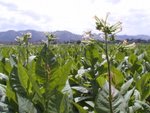Cedrela odorata

Also known as Cedrela odorata, Spanish Cedar is neither Spanish nor Cedar. Known as Cedro in Spanish, this species is part of the Meliaceae, or Mahogany, family. It is a deciduous tree found growing in Central and South America as well as the Caribbean, and the species has also been introduced in parts of Africa and Florida. Spanish Cedar is a hardwood, being a Mahogany, and it is also naturally resistant to insects due to its volatile oils, which also produce its distinct aromas.
Originally used for cigar boxes because of its resistance to pests, hygroscopic qualities, and natural abundance, Spanish Cedar is the most popular wood associated with cigar preservation and packaging. While the symbiotic relationship between cigars and Spanish Cedar has existed (and will continue to exist) for hundreds of years, it is not necessary. In fact, due to increasing conservation efforts and rising prices, Spanish Cedar is often substituted with veneers, fiberboard, teak, and other lower cost alternatives.
Sap & Dust 
Spanish Cedar is usually kiln dried to minimize the bleeding of sap. Otherwise, the sap will stick to and damage any cigars it comes into contact with. If you must remove any bleeding sap from the wood, sanding will remove most of it, but alcohol or acetate may need to be used to remove it completely. And it may continue to bleed at a later date. In addition, Spanish Cedar produces a very fine and extremely carcinogenic dust when it is cut and sanded, so great care must be taken when it is worked with.
These are just some of the challenges box makers face when they grow, harvest, dry, mill, cut, mortise, join, sand, staple, nail, and fashion this unique wood into an extraordinary packaging vehicle for our precious products. Ultimately, the journey of a cigar box is nearly as long and storied as it is for cigars.









3 comments:
this is a very interesting story! thanks for posting it. I love the smell of my spanish cedar humidor. Good to know that I have to be careful with dust of the cedrela odorata... Waht a luck I don't have to deal that much with this because my brand new adorini is ready to go and doesn't need any work on. :-)
regards.
I totally agree with laguito! great knowledge about the Spanish cedar. The smell is great and really improving the superior tast of my cuban cigars. I must admit my Liebherr ZKes 453 is not cheap, but worth all the money in the world for its qualities..
One thing is sure, this wood is very expensive! With this knowledge we now know its worth it!! My sigaren are far more better after aging for 6 months...
Post a Comment